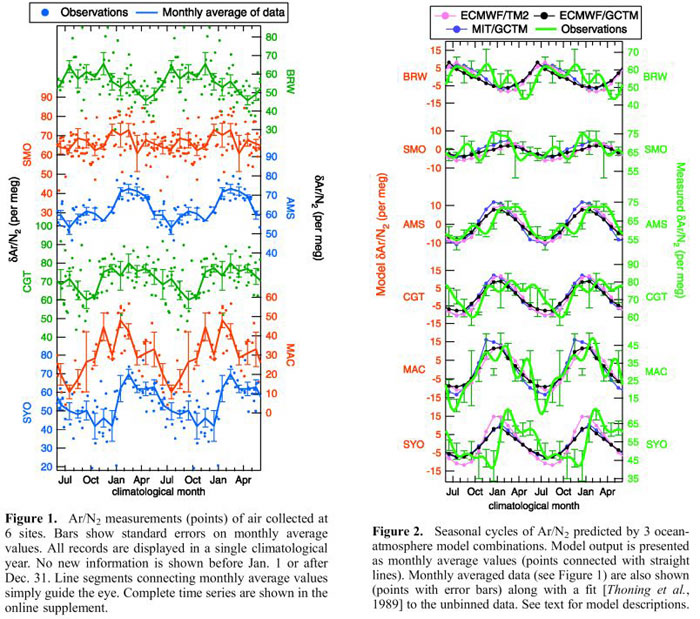
The Ar/N2 ratio of air is a unique tracer, with an ocean source function, that reflects air-sea heat fluxes, air-sea gas exchange, and atmospheric circulation. As such, its distribution tests atmospheric and oceanic models that account for these properties.
The Ar/N2 ratio of air changes because gases are less soluble in warm waters than in cool waters. During spring and summer, waters of the upper oceans warm. Gas solubilities decrease, leading to supersaturation and a flux of gases from the ocean to the atmosphere. In fall and winter, gas solubilities decrease, gases become undersaturated at the sea surface, and there is a reverse flux back into the oceans. The atmospheric inventories of all gases are higher in the summer than in the winter. The seasonal variation in gas inventory depends on solubility. Relative to the background atmospheric concentrations, air-sea fluxes of soluble gases are greater than those of insoluble gases. Thus inventories of soluble gases change more than inventories of insoluble gases. The atmospheric ratio of a more soluble gas to a less soluble gas will be higher in summer than in winter. Ar is twice as soluble as N2, consequently it is more strongly affected by air-sea fluxes in summer than in winter.
Driven by air-sea fluxes, there is an annual cycle in the Ar/N2 ratio of air, with higher values in the summer hemisphere. The amplitude of the cycle depends on the amount of Ar and N2 transferred seasonally between ocean and atmosphere, and the extent to which the surface imprint is diluted by mixing of the transferred gases to the upper atmosphere. The timing depends on the seasonal cycle of upper ocean temperatures, and the rate of gas exchange (or the relaxation timescale for air-sea disequilibrium). Upper ocean processes control the timing and magnitude of the air-sea flux, and atmospheric mixing controls dilution. Atmospheric Ar/N2 observations thus challenge models of upper ocean physics and atmospheric circulation.
The amplitude of the annual Ar/N2 cycle is 25 per meg or less (25 parts per million change in the Ar/N2 ratio, corresponding to 0.025 per mil), and its measurement presents a daunting challenge. We measure the Ar/N2 ratio along with O2/N2 on all our air samples. The uncertainty for individual samples is large, order ± 8 per meg, and we are unable to accurately describe each year's cycle. We interpret our data in terms of climatology, adding all results for each station to construct a record for a virtual climatological year. These results can then be compared with model predictions.
The key result of an initial study is that models do a reasonable job of accounting for the amplitude of the annual cycle, but a poor job of describing the timing of the springtime increase (Battle et al., 2003). This study used a model in which warming (cooling) at the surface was accompanied by an instantaneous flux of gases to (from) the atmosphere. In a more recent modeling study, Professor Galen McKinley (a Princeton Postdoc, now at University of Wisconsin) used a model with explicit upper ocean mixing and gas exchange. These processes cause gas fluxes to lag the heat fluxes that drive them; adding them to the model beings data and simulation into better agreement.
Future research involves improving the climatology as we collect more data, improving data quality with automated sampling, and examining the nature of data-model discrepancies.
